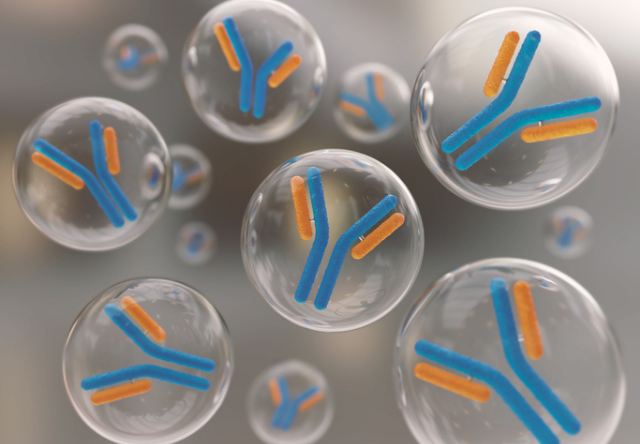On this week’s blog, we are going to begin detailing the amazingly complex web we call colostrum, which surprisingly, scientists are still unraveling. However, we have a good understanding of the main constituents and how they work. These blog entries will not be an exhaustive list of every component of colostrum but they will be indicative of how complex this life-giving substance is.
Immune Components
Immunoglobulins
The natural environment contains a large variety of infectious microbial agents— bacteria, viruses, and fungi. If left unchecked and allowed to multiply, pathogenic species will eventually kill the host. In normal healthy animals, most infections are of limited duration and cause little if any permanent damage. This is due to the immune system—a natural defense mechanism that helps ward off or combat infectious agents.
Immunoglobulins have an integral role in this defense system in that they function as antibodies. There are five classes of immunoglobulin recognized in mammals: IgG, IgA, IgM, IgE, and IgD. While the most prevalent class in most mammals is IgG, the other immunoglobulins also have very important functions. The fact that in human milk and colostrum IgA is the predominant immunoglobulin should be noted. The main function of these molecules is to bind to invading organisms and to activate specific mechanisms that help rid the body of disease-causing agents.
In human and animal trials, it has been demonstrated that specific antibodies exist in bovine colostrum which are effective against both enteropathogenic and enterotoxigenic organisms.
Their Role in the Immune System
Immunoglobulins are also known as antibodies. They are the main component of the adaptive immune system. When an antigen (a foreign protein) is discovered in the body by immune scout cells, a chain of events is begun that results in antibodies specific to that antigen being produced by certain blood cells called B lymphocytes. The antigen might be a protein from a bacteria or virus, or it could be from a toxin. It could even be a protein produced by your own body, as happens in the case of autoimmune conditions. These specific antibodies fit the antigen like a key fits a lock. The disabled antigen can then be targeted for elimination by the immune system. There are different types of immunoglobulins found in the body, and these are also found in colostrum.
Immunoglobulins are glycoproteins and are present in serum and other tissue fluids, including the milk and colostrum of all mammals. Antibodies are produced in response to the host being exposed to immunogenic foreign substances (antigens), such as infectious microbes. They are an important element in the adaptive immune response in that they are directed specifically to the antigen that induced their formation, and then they impart memory. In this manner the body is effectively prepared to repel any later invasion by the same organism.
In the Form of Antibodies
Antibodies are produced by activated B cell lymphocytes (plasma cells). Each plasma cell secretes one class of antibody, and all the antibody produced by a single plasma cell is of the same specificity. There are five classes of immunoglobulin that are recognized in mammals: IgG, IgA, IgM, IgE and IgD. The most prevalent class of immunoglobulin in all species of animals is IgG. However, in humans the IgA class is the predominant form found in breast milk and colostrum. The function of these molecules is to bind to invading organisms and actions that help rid the body of disease-causing agents. They function in cell-killing, inflammation, and prevention of bacterial and viral attachment.
lgG is the form in which antibodies occur most abundantly. In all species of mammals IgG is passed from the mother to its young, although the actual mechanism of transmission varies from species to species. In humans and apes it has been shown that IgG and its complement of antibodies pass across the placental barrier from mother to fetus during the second two-thirds of gestation. This passage appears to be selective in that IgG is transferred but not the other immunoglobulins. Albumin is also transferred, but to a lesser degree. Other plasma proteins are not transferred across the placental barrier. In cattle it appears that the same type of selection occurs in absorption of antibody through the gut in that there is a preferential passage of IgG but not IgA, IgM, IgD or IgE.
Immunoglobulins in Colostrum
Immune factors in colostrum include immunoglobulins (A, D, E, G, M), cytokines, including interleukins 1, 3, 4, 5, 6, 8, 10, 12, 13, 16, 18, interferon-y, and lymphok ines, leukocytes, lactoferrin, Proline-rich Polypeptides (PRPs), protease inhibitors, trypsin inhibitors, antibodies, glycoproteins, Lactobacillus, Bifidus, Acidophilus, oli gopolysaccharides, glycoconjugates, orotic acid, secretory IgA, IgA specific helper, B-lactoglobulin, lactalbumin, albumin, prealbumin, alpha-| antitripsin, alpha-l fe toprotein, alpha-2 macroglobulin, alpha-2 AP glycoprotein, C3 and C4 oroso mucoids, lysozyme, lactoperoxidase, thiocyanate, peroxidase, xanthine oxidase, vitamins A, B,,, E, and sulfur.




0 Comments